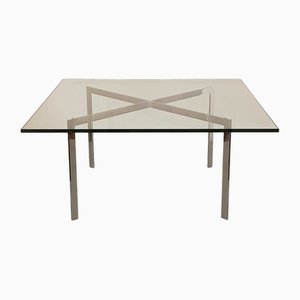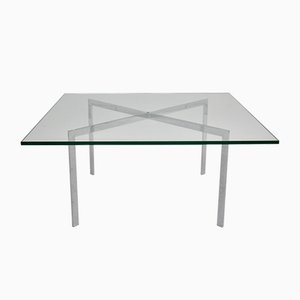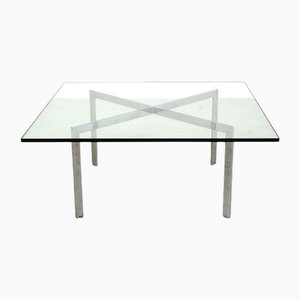
Modern architect and furniture designer Ludwig Mies van der Rohe was born in Aachen, Germany in 1886. He attended the Domschule in Aachen until 1900 and then spent two years at a local trade school, while also working on building sites for his father, a master stonemason. From 1903 to 1904, he worked as a draughtsman and designer for a local firm specializing in stucco decoration. He moved to Berlin in 1905 and became an apprentice to Art Nouveau architect and designer Bruno Paul. An independent commission to design his first house came from philosopher Alois Riehl, who sent Mies to Italy for three months for inspiration. The Riehl House was completed in 1907 in Potsdam, south of Berlin and brought Mies to the attention of designer and architect Peter Behrens, for whom he worked between 1908 and 1912. He established his own architectural and design office in 1912 in Berlin and built three houses in the city before the outbreak of World War I. From 1915 to 1918, he served in the German Army’s Engineer Corps.
During the 1920s, Mies was active in Berlin’s avant-garde circles, participating in organizations like the Novembergruppe and Zehner Ring and contributing to the magazine G. He began studying and designing skyscrapers, which, while not built, portended future designs. He also directed the Weißenhofsiedlung exhibition in Stuttgart, a model housing colony project for which he invited the era’s most accomplished European architects to participate—including Walter Gropius and Le Corbusier—and 20 permanent residential buildings were built around his own steel-framed apartments, revealing a series of individual interpretations of workers’ housing. This project introduced him to Lilly Reich and the pair collaborated frequently over the next decade. His other major project of this era was the German (or Barcelona) Pavilion, built for the German section of the 1929 Barcelona International Exposition, which helped establish him on an international stage. Using glass and marble interior walls that could be easily moved, he merged interior and exterior spaces, emphasizing a fluidity of space and incorporating specially designed furniture, including the iconic leather and chrome Barcelona chair. Shortly after, in 1932, his work was included in the first architectural exhibition at the Museum of Modern Art in New York, entitled Modern Architecture: An International Exhibition, which helped introduce his work to an American audience. From 1930 to 1933, he served as Director of the Bauhaus; under political pressure from the Nazis, he moved the school from Dessau to Steglitz, Berlin and ultimately closed the school in 1933.
In 1938, Mies moved to Chicago, re-established his architectural firm, and served as the Director of the Architecture Department of the Armour Institute for the next 20 years (it became the College of Architecture, Planning and Design at Illinois Institute of Technology in 1940). In the 1940s, he designed a new campus for the school, a project that further refined his steel-and-glass aesthetic. In 1944, he was naturalized as an American citizen and went on to design a number of notable buildings in the US, including, between 1945 and 1950, the famed Farnsworth House outside of Chicago. The radically minimalist home consists of an open-plan interior space with concrete roof and floor slabs, subdivided by partitions, and completely enclosed in glass. Mies also designed multiple high-rise buildings, such as Chicago’s 860–880 Lake Shore Drive Apartments (1951) and New York’s Seagram Building (1958), which embraced the notion that buildings should accommodate changing lifestyle requirements.
Mies van der Rohe was awarded, among other honors, the Gold Medal of the Royal Institute of British Architects (1959) and the US Presidential Medal of Freedom (1963). He passed away in Chicago in 1969 and is buried in Graceland Cemetery.





